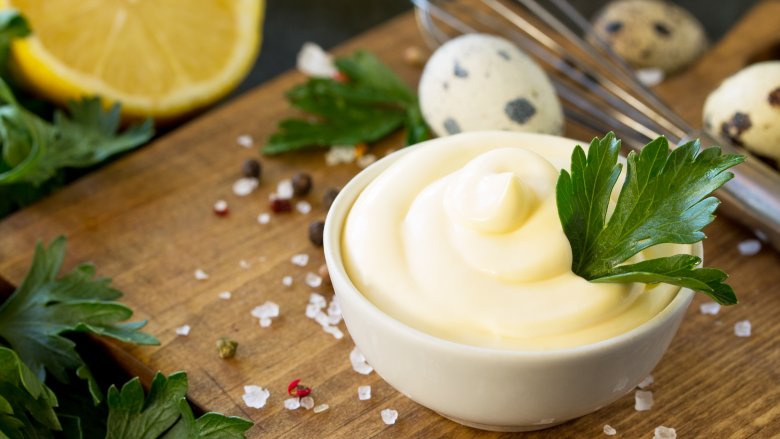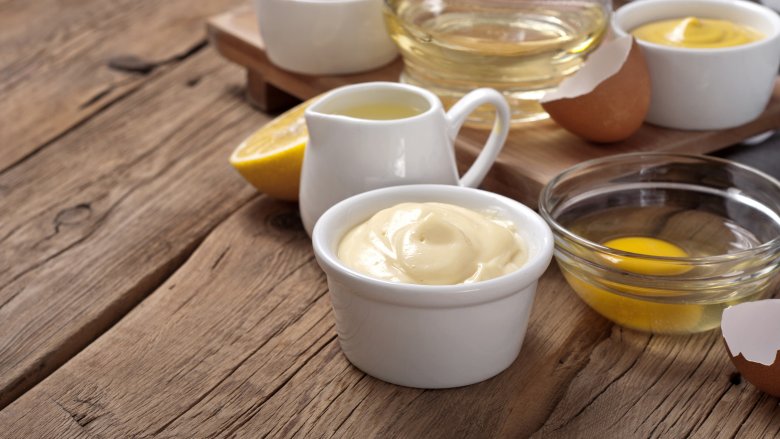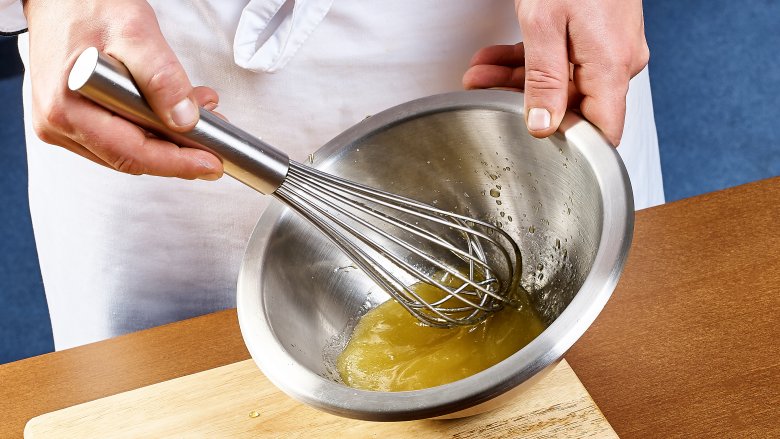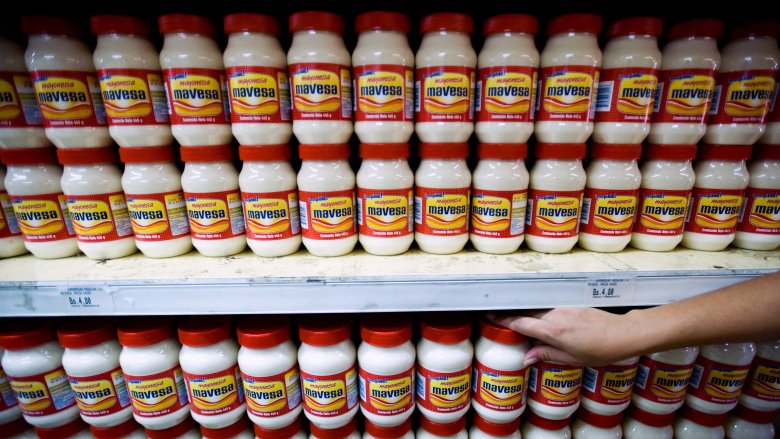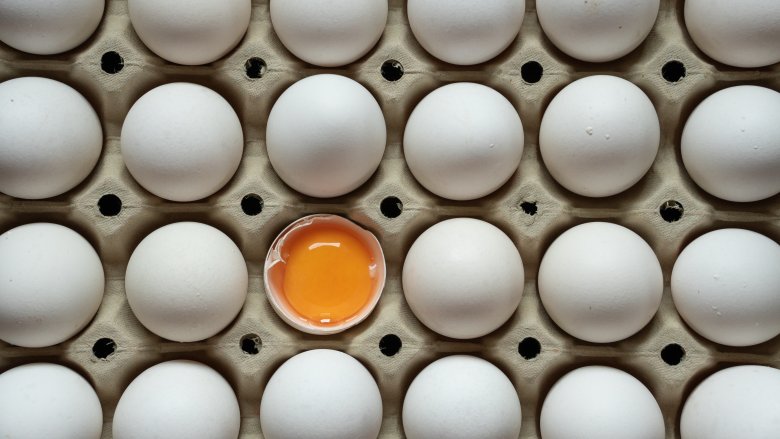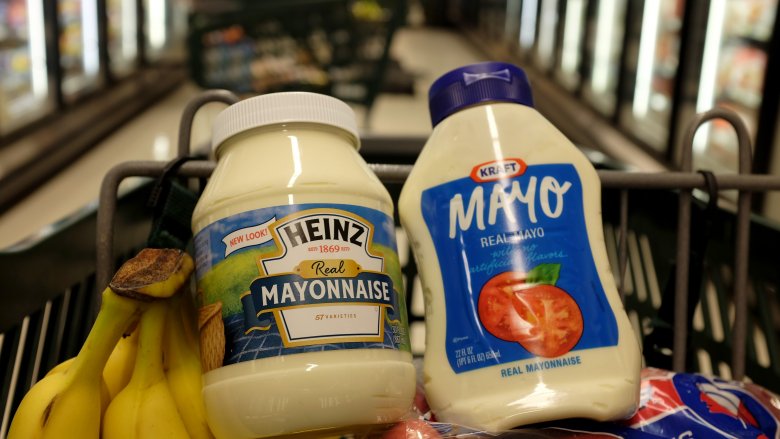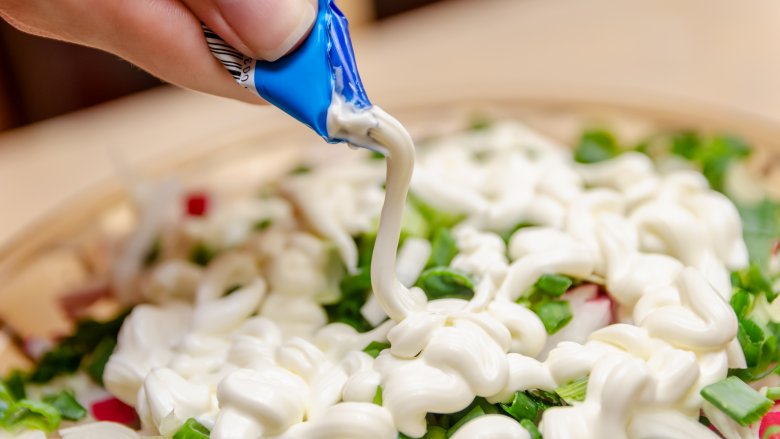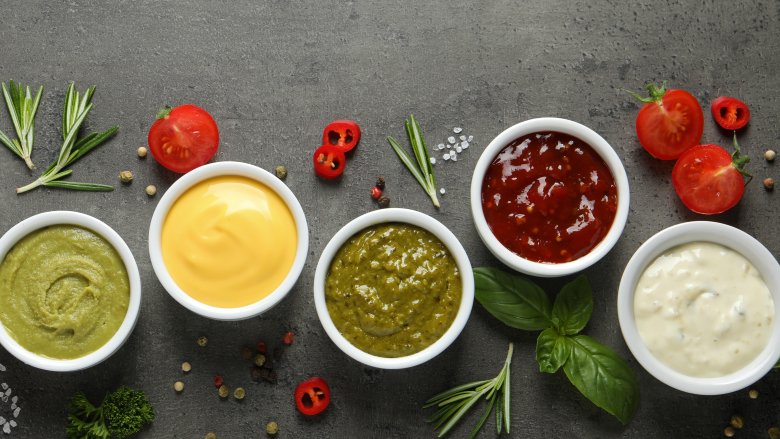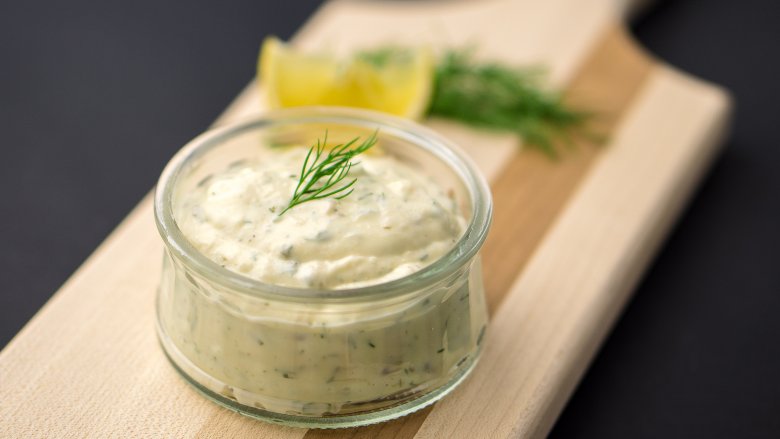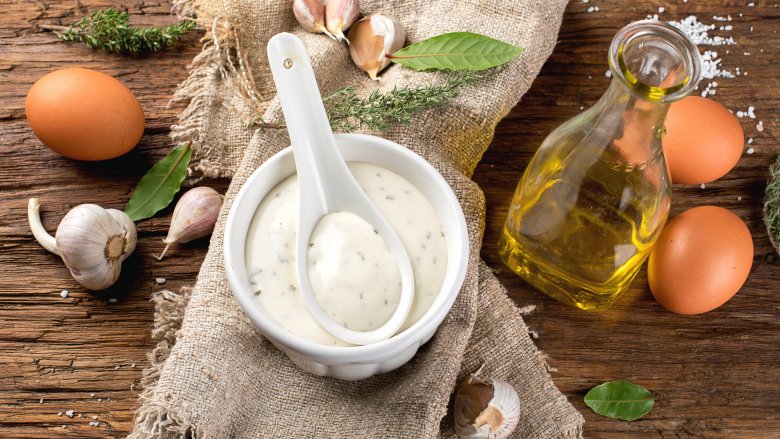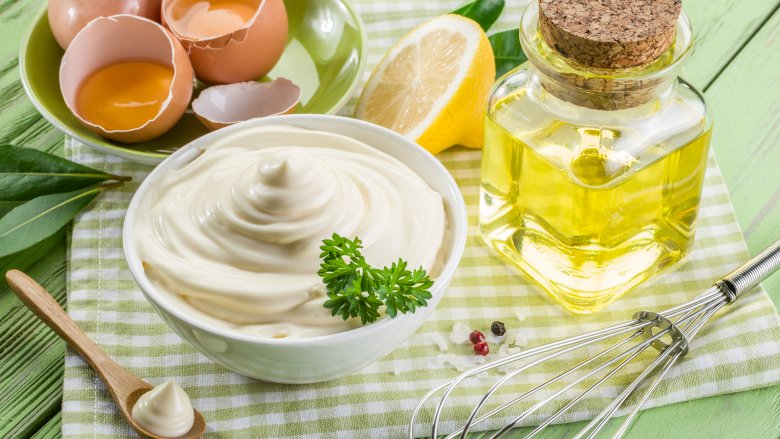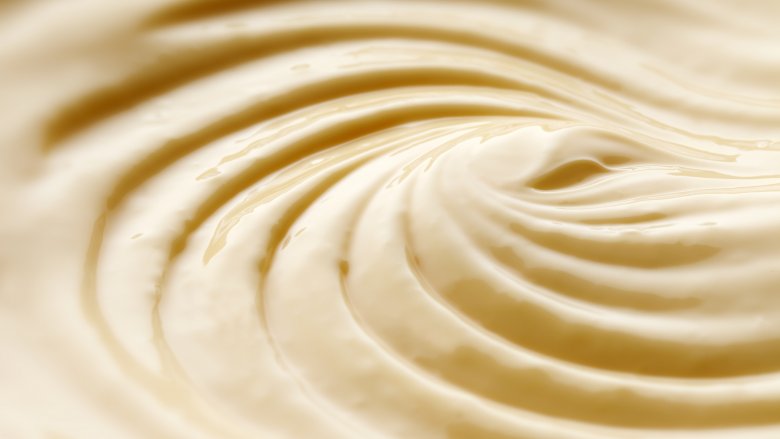This Is How Mayonnaise Is Really Made
Put down that bottle of ketchup for a second — we need to talk about its little brother, mayo. You see, mayonnaise is a fascinating condiment. No, don't scoff; condiments can be fascinating. Because mayo is far more than just a white spread that goes surprisingly well with fries, and the stuff actually enjoys a rich and varied history, a whole smorgasbord of different varieties, and countless uses inside and outside the kitchen. Trust us, you won't find many sriracha face masks floating about out there.
Beyond all that, however, mayonnaise also relies on an intriguing chemical process in order to come together — one which binds those key ingredients into far more than the sum of its parts. And the way it's made at home is extremely different from the way they make the kind you buy at the grocery store.
Of course, if you're not so into the geeky stuff, there's always the fact that it's just downright delicious. Honestly, there's something for everyone here. So buckle up — because from eggs to emulsifiers, and oil to aioli, this is how mayonnaise is really made — and a little bit about where it came from.
The easy way to make mayonnaise at home
Let's start with the simple stuff. If you're not big on buying your mayo off the grocery store shelf — or if you just like trying your hand at new recipes — you can absolutely make your mayonnaise yourself. All you need to make a basic, homemade mayonnaise is a couple of egg yolks, some mixed oils, an acidic ingredient (such as vinegar or lemon juice) and a little salt. That's it!
The method is just as simple. Whisk the egg yolks in a bowl, then slowly add about half the oil while still whisking, until the mixture has thickened. Then whisk in a little vinegar or lemon juice, and gradually add the remaining oil, whisking the whole time. Season with the salt, add as much more of the acid as you need, then store in the refrigerator for use.
Obviously, that's about the most basic recipe you can possibly use, and it's very easy to spice it up however you like — the recipe above suggests using a little Dijon mustard, but it really is up to you. Experiment, have fun with it and see what you can come up with, because there's so much you can do with mayonnaise, and so many different ways of putting a new spin on the standard recipe. (More on that later, though.)
You can't make mayonnaise without emulsification
It might seem like cooking wizardry, but mayonnaise comes about from all that whisking because of a very specific chemical process: emulsification.
You see, some liquids aren't supposed to be mixed together, and oil and vinegar are just two of these types of liquids. Whisk them together in a bowl, mix them up, stop whisking and they'll quickly separate. And that's where the egg comes in. Egg yolk contains lecithin, which is a fat emulsifier. Adding it to the mixture of oil and vinegar creates what's known as a colloid, which is a substance that consists of tiny particles (which are slightly larger than atomic molecules) from one substance — in this case the mixture of vinegar and oil — spread out through a second substance; that's your egg yolk. Because the particles do not settle, they can't separate out and instead stay bonded together.
Essentially, adding the egg yolk emulsifier to the mixture of oil and vinegar binds them together and prevents the mix from separating — creating, in the end, mayonnaise. Think of it like glue, but tastier.
Simple, right?
The industrial process for making mayonnaise
So you know how to make mayonnaise at home. But what about the big brands? After all, major food corporations aren't going to have chefs hand-whisking their mayo in a quaint country kitchen — much as they'd probably like to market it that way. No, step into the factories and you'll find a rather more impressive — if familiar — operation taking place.
In the United States, the FDA regulates that mayonnaise must contain 65 percent oil in its recipe, as well as vinegar, egg, or egg yolk. You can throw in almost anything else, but you've gotta have those ingredients to be counted as mayo. Strangely enough, turmeric and saffron are out as ingredients, since they yellow the mayonnaise and could give consumers the impression it contains more egg yolks.
During the process itself, a continuous blending system (much like whisking) is used to sustain the emulsification of the key ingredients. The mixture of vinegar and oil is pushed through a series of pumps to and from large cavities, while extra ingredients (such as mustard, garlic or anything like that) are piped in through openings in the side of and above the pumps. Finally, the mayonnaise is pumped down to a bottling station, and measured amounts are poured into the jars. Some are given taste tests for quality control, and the rest are shipped off to stores.
Good mayonnaise needs good eggs
Any chef worth their egg yolk emulsifier will tell you that a recipe is only as good as its ingredients, and it goes without saying that good eggs will go along way toward giving you good mayo. Bad eggs, however — or poor conditions for the chickens laying them — will give you bad mayo, and maybe even a guilt-ridden conscience to boot. And while some mayonnaise producers have committed to slightly improving standards for their chickens, there's still a long way to go in that particular field.
If you wanted to, you could always opt for a vegan mayo and cut out the animal involvement altogether — there are plenty of vegan-friendly choices on the market. But according to the FDA, mayonnaise made without eggs isn't mayonnaise at all. Instead, it's a mayo-like dressing or a sauce — though there's nothing to stop you from using it like you would a mayonnaise.
Battle of the mayonnaise brands
Let's say you do want to save a little time and opt for a big brand mayo for your kitchen at home. Who do you go for? The choices are many, and if you're already a big mayonnaise eater, then the idea of moving out of your mayonnaise-based comfort zone might not seem too appealing. But don't dismiss the idea too readily.
The folks over at Serious Eats performed a taste test of the major brands in early 2019 that included Duke's, Kraft, Whole Food 365, Miracle Whip (yeah, we know, but they included it for variety's sake), Trader Joe's, Hellman's, Best Foods, Kewpie, and Blue Plate. Each was tasted plain, then with some blanched asparagus, then added into a potato salad. The tasters were asked to rank each mayonnaise in terms of sweetness, tanginess, and overall preference, as well as provide written feedback.
The result? Trader Joe's proved the sweetest, Kewpie the most tangy, and Kraft won overall. According to the taste testers, Kraft's mayo was "brightest, freshest, and most interesting [...] of the lot," and was lauded particularly for its onion, garlic, and paprika flavor. Duke's and Trader Joe's came in tied at second, while Hellman's took third. Down at the bottom, surprising nobody, was Miracle Whip, which contains not just egg, oil, and vinegar but also fructose corn syrup, and turned out to be "excessively cloying and unnatural tasting." Well, yeah.
How healthier mayonnaise is made
Everyone's on a health kick these days, and a little wholesome eating never exactly hurt anyone. So you'd be forgiven for balking at the fatty contents of mayonnaise and opting for something better for you instead. Of course, you might also opt for low-fat mayo. The question is, should you? And if so, which is best?
Time for another taste test, this time from WebMD. According to them, mayonnaise branded as "light" tends to use water as the main ingredient rather than oil, while fat-free mayo uses water, sugar, and modified food starch. WebMD's testers preferred Hellman's Mayonnaise Dressing With Extra Virgin Olive Oil as a light mayo, on the basis that it tastes like regular mayonnaise and uses the same ingredients used in the homemade stuff.
If you're making it at home, using water is one option to stay healthy, but making your mayonnaise with egg whites is another. In that case, you'll get all the nutrients of egg whites, including vitamin B, potassium, and protein without any of the fat of the egg yolk. Winner!
Spicing up your mayonnaise
Of course, the thing you're most likely wanting to do with your mayonnaise recipe is spice it up with some extra ingredients. And you wouldn't be the first to do so, either — nowadays, there are as many varieties of mayonnaise as there are ingredients under the sun. If you've eaten at any kind of restaurant recently, or been in a store, or even scoured online for mayo recipes, you're bound to have come across a few special kinds, some of which are arguably better than the cool, white original.
Some of the varieties on mayonnaise that you might come across include herb-based mayos, such as basil, dill, chive, or ranch mayo; hot mayos, such as chipotle, peppercorn, kimchi, or wasabi; umami flavors such as blue cheese, Parmesan, garlic, or pecan; smoky mayos like bacon, smoked paprika, or smoked cheese; other miscellaneous varieties such as sundried tomato, teriyaki, red pepper, or curry; or even sweet mayos like raspberry, apple, or cranberry. The possibilities are quite literally endless, and the menu is only limited by your imagination. We're still holding out for ice cream mayo. (After all, there is a mustard variety.)
On second thoughts, maybe not.
Mayonnaise can be used to make awesome sauces
And just like how you can influence mayonnaise with other ingredients, so too can you use mayonnaise to influence other sauces. In fact, mayonnaise is a vital component of many famous sauces, proving that this criminally underrated condiment has been hauling its culinary weight far more quietly and effectively than that red stuff people keep slathering over their food.
Anyway, some sauces that involve mayonnaise include ranch dressing, which is made from mayo, sour cream, and minced onions; remoulade, a kind of mayonnaise/mustard sauce that includes gherkin pickles, capers, parsley, chervil, tarragon and occasionally anchovies; tartar sauce, which is mayonnaise with pickles, onion, capers, olives and crushed egg; honey mustard dressing, which throws brown sugar, lemon juice and mustard into the equation; and Thousand Island dressing, which is made from mayo, tomato sauce, sweet pickles and herbs.
So if you feel like you've experimented as much as you like with new mayos, why not try messing around with mayo as a base for a new condiment or sauce? You never know what you might invent.
Aioli vs. mayonnaise
You've probably heard of aioli before. Unless you know any better, there's also a good chance you use the term more or less interchangeably with mayonnaise. But the truth is there are a few crucial differences between them.
For one, aioli very specifically comes from the region of Provence in France, and isn't made with a blender or a whisk. Instead, aioli is made by pasting garlic with a mortar and pestle, before adding to a combination of egg yolk, lemon juice, mustard and olive oil. And while mayonnaise is an incredibly versatile sauce that is used in all kinds of ways, aioli is used pretty much exclusively as a dip, usually for shellfish, boiled eggs, or vegetable crudite.
There are similarities, though. They're both emulsions, and work off the same chemical process as each other. Some Mediterranean recipes insist that aioli is made simply with olive oil, mashed garlic, and salt, eschewing the use of acid or egg yolk. In many places, of course, "aioli" basically means "garlic mayonnaise," and the terms have become practically synonymous.
Mayonnaise has some murky origins
Considering how critical mayonnaise's impact on modern cooking has been, it should come as little surprise that the sauce has a long and storied history, too. And although it's possible to trace mayo's past over the last few centuries, there is some disagreement as to where and when it actually originated.
More specifically, there's a great deal of bad blood between Spain and France over who actually invented mayonnaise. One origin story suggests that mayonnaise was invented in 1756 during the siege of Port Mahon on the island of Minorca. The personal chef of the Duke de Richelieu, who led the French, found the island lacked the cream he was looking to use in a dish and ended up invented "mahonnaise" in its place. Food writer Tom Nealon, however, has suggested the Spanish view that they invented mayonnaise is accurate. "The fact that mayo doesn't show up in any of the initial 17th century [French] recipe collections," he says, "does seem to confirm that the French didn't have the 'technology' for mayonnaise until the 18th century."
Mayonnaise historian (yes, we know) Andrew Smith, on the other hand, has said: "All of the early recipes say French. I believe it."
Why is it called mayonnaise?
People can't even really agree over why it's called mayonnaise in the first place. There's the "mahonnaise" theory, of course, which posits that it's named after Port Mahon. But Tom Nealon's account insists that the Spanish origins of the dish, which do lie on the island of Minorca, mean we ought to be calling it "Salsa Mahonesa," as the natives did. Of course, he also suggests that the French assault on Port Mahon was an attempt to seize the sauce for themselves, which... seems unlikely.
Haute cuisine pioneer Antoine Careme claims the word "mayonnaise" derives from the French verb "manier," which means "to stir." It could also be a corruption of the word "moyeunaise," a word derived from the Old French word "moyeu," which means "egg yolk." And then you've got the theories that the word derives from "Bayonnaise," based off the town of Bayonne in southern France. This notion goes off the assumption that the thick French accent gradually eroded that "B" to an "M" over time, and "Bayonnaise" eventually became "mayonnaise."
Bon Appetit believe aioli is the real source of the mayonnaise sauce, and that mayonnaise was a development on the original recipe of garlic and oil. They note that Bayonne and Mahon both sit at opposite sides of the culinary regions in which aioli originated, regions that also share French and Spanish linguistic traditions. It's from these regions, they say, that mayonnaise, too, almost certainly came.
Sadly, however, the specifics appear to have been lost to time.
Mayonnaise has a long history
Once you move past those initial controversies, however, the history of mayonnaise begins to become a lot clearer. From its birthplace somewhere in Europe, mayonnaise quickly spread and became popular around the continent. The English used it in sandwiches, while Germans, Russians and Scandinavians used it in sauces for fish and potatoes. This was also the period in which mayonnaise inspired new sauces, such as remoulade and tartar sauce. From there, European immigrants brought the recipe over to America. For much of this era, mayonnaise was a luxury because it was so difficult to make, but that all changed with the invention of the egg beater.
Suddenly, mayonnaise became a hugely popular dish in restaurants across the United States. In the 1910s, a German-born businessman named Richard Hellman began to package his mayonnaise for sale at his New York deli. With the boom in home refrigerator in the mid-20th century, it became a common feature of practically every kitchen. In 2019, an estimated 271 million Americans will have used mayonnaise at some point or another. Not bad for a few eggs, a splash of vinegar and a little oil, right?
